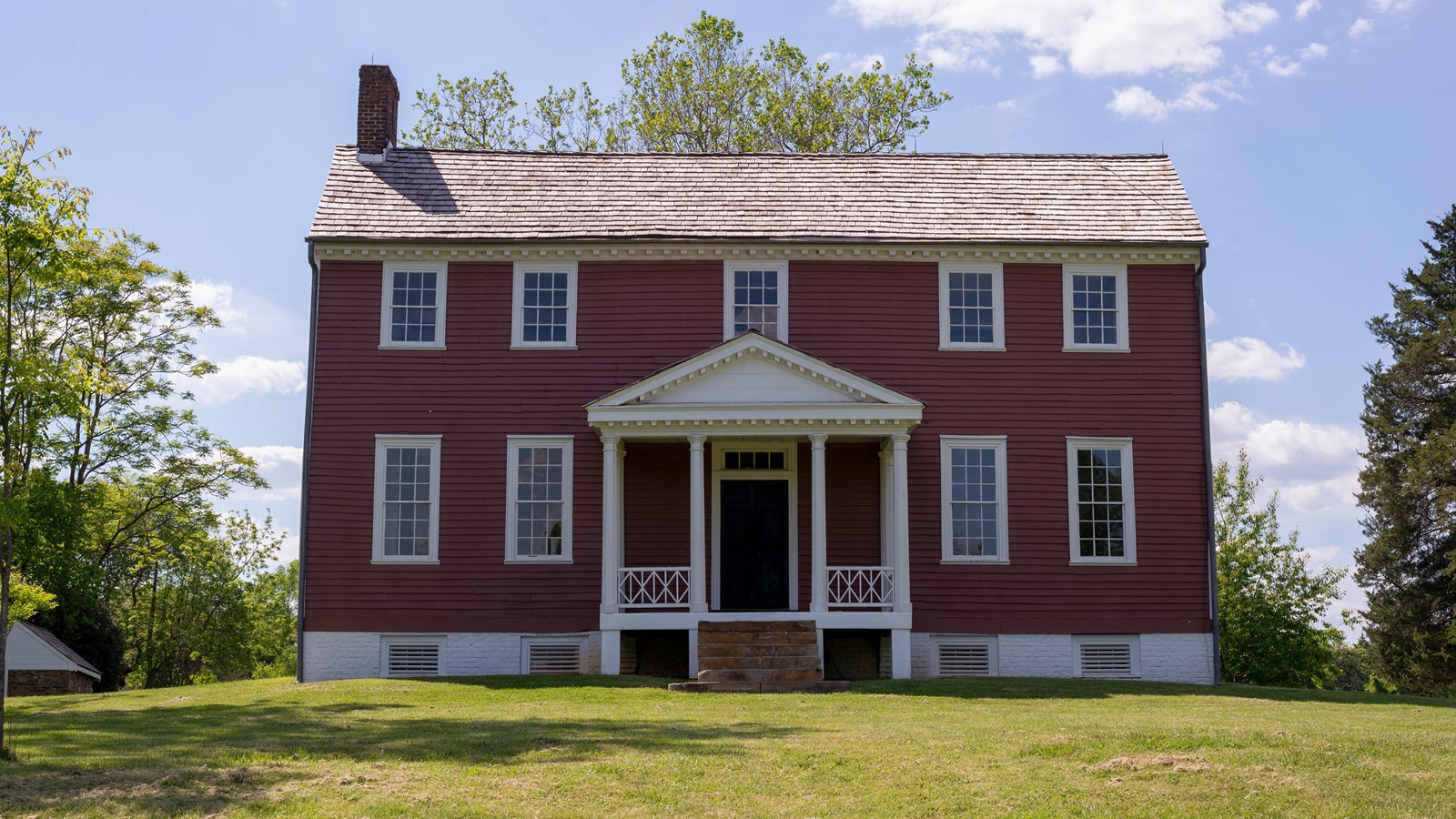Last updated: January 5, 2025
Place
Ellwood House

NPS Photo
Historical/Interpretive Information/Exhibits, Restroom - Accessible
Ellwood is open seasonally. For current hours visit the Operating Hours & Seasons page. The Ellwood grounds are open sunrise to sunset. To visig when the house is closed, park outside the gate (but not blocking the gate) to walk 0.4 miles to the grounds.
Today, the main house at Ellwood is the only structure from the 1700s that still stands. Perched on a knoll overlooking Wilderness Run, Ellwood stood at the center of an extensive 5,000-acre tract of land that encompassed much of what in 1864 would become the Wilderness Battlefield. Ellwood was home to the plantation's owners as well as the people they enslaved. Many important events took place here during the Civil War, forever changing the lives of the people who called Ellwood home.
Ellwood in the Civil War
When the Civil War erupted in 1861, James Horace Lacy, a vocal supporter of secession and slavery, enlisted in the Confederate Army. While the Lacys likely viewed the war as a threat to their their wealth and status, enslaved people here and across the country understood that the instability of war could lead to freedom.
Shortly after Horace's departure, Betty and her children moved into the town of Fredericksburg, then to a farm in southern Virginia. They brought a portion of the enslaved population with them to southern Virginia, and left a smaller number of enslaved people behind, trusting that they would remain, as Betty Lacy said, “faithful.”
The actions of enslaved people here proved otherwise. Charles Sprout, an enslaved man born at Ellwood, fled to U.S. lines early in the war and joined the U.S. Army. On January 1, 1863, the remaining enslaved people at Ellwood were freed through the passage of the Emancipation Proclamation. Coupled with the arrival of the U.S. Army in the Wilderness three months later, enslaved people here had a chance to leave Ellwood forever.
In early May 1863, the warring armies clashed at Chancellorsville, five miles east of Ellwood. On the evening of May 2, after a successful flank attack against the Union Army, Confederate troops mistakenly shot General “Stonewall” Jackson and his staff. The surviving members of the party carried Jackson to a field hospital near Wilderness Tavern, where doctors amputated his left arm. As General Jackson recovered, his chaplain, Beverly Tucker Lacy, took the amputated arm to Ellwood, his brother’s plantation, and buried it in the family cemetery. Meanwhile a team of Confederate surgeons used Ellwood as a hospital in the battle’s aftermath. Hospital staff buried an additional twenty-four Confederate soldiers on the plantation grounds. The hospital at Ellwood remained in operation through the fall.
The armies returned to the Wilderness a year later. The upcoming presidential election and the introduction of the 13th Amendment in Congress added a sense of urgency to the war effort on both sides. Understanding the uncertainty of his reelection, President Abraham Lincoln looked for an opportunity to push the United States towards victory. In March, Lincoln promoted Grant to general-in-chief of all U.S. forces. Grant took up his headquarters with the Army of the Potomac in Virginia. On May 4th, 1864, the Army of the Potomac crossed the Rapidan River and moved into the Wilderness. Their movement marked the beginning of the Overland Campaign. As the U.S. Army moved down the Orange Turnpike on May 5th, they clashed with Lee’s army at Saunders Field, one mile west of Ellwood. The head of the U.S. Fifth Corps, General Gouverneur Warren, set up his headquarters at Ellwood. Around 1:00 p.m., Warren’s soldiers advanced through Saunders Field.
After a day of brutal, inconclusive fighting, General Warren returned to his headquarters at Ellwood. His men recovered on the plantation grounds. Warren went into the main house and retired in the room to left of the front door. There, he reviewed casualty counts with his surgeon, John Milhau, and adjutant general, Frederick Locke. An onlooker, Lieutenant Morris Schaff, described the scene: “Just as I passed them, I heard Milhau give a figure, his aggregate from data which he had gathered at the hospitals.” Schaff then remembered Warren stating, “It will never do to, Locke, to make a showing of such heavy losses. Warren, an experienced soldier, reacted to the costliness of the new campaign, and likely predicted the impact that a high casualty count would have on morale.
Unbeknownst to Warren at the time, the Wilderness was only the first in a long series of battles that lasted through the summer. This second day of fighting did not bring victory to the U.S. Army. Refusing to accept the battle’s outcome as a failure, Grant led his army southeast for Spotsylvania Court House, where the fighting resumed on May 8th. The Battle of the Wilderness altered the landscape around Ellwood. Patches of scorched ground, felled trees, graves, and entrenchments stood as evidence of a brutal struggle.
